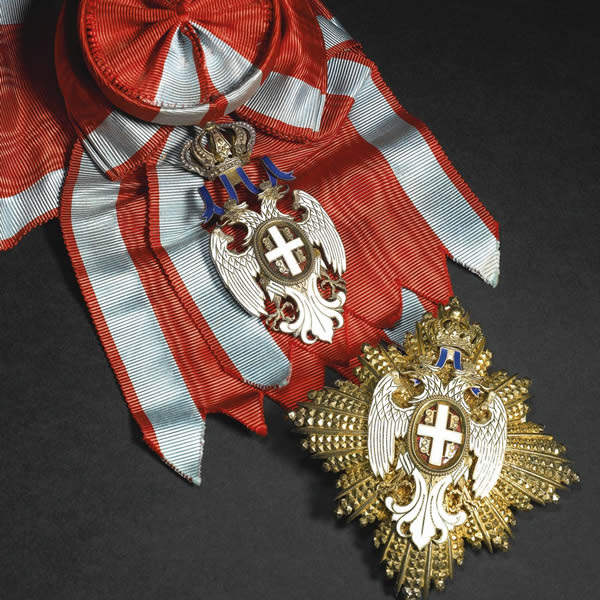Decorations of the Serbian and Yugoslav Monarchy from 1859 until WWII and of the formerly reigning Royal House until present day
Following the successful 1804-1815 revolts against the ailing Ottoman Empire, Serbs achieved autonomy as hereditary principality in 1830 and eventually full independence in 1878. Their early leaders wore decorations bestowed to them by foreign powers – each with their own interests for awarding them – but it was not until 1859 that the first domestic honors were founded.
The First Medals
Prince Milosh Obrenovich (1780/1783-1860) returned to Serbia in 1858 from long exile, right amidst political turmoil that eventually ousted his contender from the rival Karageorgevich dynasty from power. Milosh commemorated the event in the following year by establishing not one, but three medals – an extraordinary move at the time for a head of a tributary and not a fully sovereign state. To those parliamentarians who voted in favor of his return to power, Milosh awarded the Medal “For Loyalty” (or Cross “For Loyalty” if they were members of the clergy) and a commemorative Medal of the Event to other deputies.
Modern Orders for the Modern State
To commemorate the half-centenary of the Second anti-Ottoman Revolt started by Milosh in the Takovo region in western Serbia, his son and heir Prince Michael III (1823-1868) – a Vienna-educated, progressive and enlightened absolutist – issued a single-class commemorative Cross of Takovo in 1865, which his cousin and successor Prince Milan IV (1854-1901) later expended into a fully fledged order of merit in five classes and separate civil and military divisions.
After the Berlin Congress granted full international recognition to Serbia, Milan elevated the Principality to Kingdom in 1882, changed his royal style into Milan I and in the following year founded Orders of the White Eagle and of St. Sava, both in five classes.
Milan’s son and heir Alexander I (1876-1903) founded the lavishly manufactured Order of St. Prince Lazar in 1889, and in 1898 the short lived Order of Milosh the Great in four classes, the rarest Serbian order of merit ever, with only 9 Grand Crosses ever conferred.
Out with the old, in with the new (albeit not always)
The rival Karageorgevichs reclaimed the throne after Alexander’s assassination in 1903. King Peter I (1844-1921) retained some and abolished other orders previously founded by the rival dynasty and in the next year founded the Order of the Star of Karageorge in four classes as the premier order of merit. Ultimately, Peter’s son and heir Alexander I of Yugoslavia (1888-1934) founded the Order of Yugoslav Crown in five classes, the last monarchical order of merit associated with Serbia.
In exile, to present day
With the monarchy abolished after World War II, the extant royal decorations were retained by the exiled King Peter II of Yugoslavia (1923-1970), who never abdicated, as part of his royal prerogative. Post-war socialist Yugoslavia abolished the system of royal honors within its jurisdiction, but apparently recognized certain rights of the recipients for military merits, excluding those decorated during WWII. Although living in somewhat reduced circumstances, King Peter II did not compromise the integrity of royal honors by bestowing for benefit or profit (being formerly regnant king and not just a claimant, his bestowals would be considered to have higher value).
Under construction – Constantly updated – Please visit regularly
